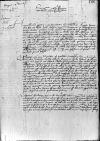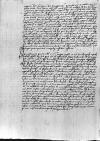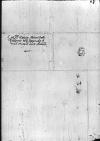Accepi 1527-11-03⌊tertia huius mensis1527-11-03⌋ ⌊⌋ Maiestatis Vestrae Serenissimae ⌊Cracoviae⌋ 1527-08-15⌊15 Augusti praeteriti1527-08-15⌋ datas, quibus mihi declarat, qua de re hucusque me non revocaverit iniungitque, ut hic in aula ⌊caesareae maiestatis⌋ ulterius et tamdiu perseverem curando ea, quae mihi commissa sunt et quae ad illarum rerum commodum et ad conservandam mutuam benevolentiam cum maiestate caesarea spectant, donec pro istorum temporum ratione me revocandum duxerit. Quod cum sic Maiestas Vestra Serenissima habere vult, quamvis mora haec non poterit mihi esse non molesta, utpote iam quartum brevi annum expletura, mandatis tamen Maiestatis Vestrae Serenissimae etiam usque ad ultimum halitum obsequendum est, cumque non possum id, quod volo, id volo, quod possum.
Quod Maiestas Vestra Serenissima scribit de ⌊palatino Siradiensi⌋, hoc mihi iam dudum hic innotuit eratque constans fama in aula ⌊caesaris⌋, quod illum Maiestas Vestra Serenissima ad ⌊regem christianissimum⌋ miserat. Ego tamen, quantum coniectura assequi potui, qui etiam quosdam nostros cf. Adagia 1.9.89 ⌊intus et in cutecf. Adagia 1.9.89 ⌋ novi, factum id non esse de mente Maiestatis Vestrae Serenissimae omnibus respondi, verum apud nos esse aliquos, quemadmodum ubique fere, qui partes Gallicas sequerentur quique ⌊illius regis⌋ addicti forent servitio et quod isti passim hinc inde vagarentur et se negotiis immiscerent sine Maiestatis Vestrae Serenissimae scientia et voluntate, quod ad praesens cum his Maiestatis Vestrae Serenissimae ⌊⌋, quae ad id mihi opportune venerunt, liquidius sum comprobaturus. De his plura essent scribenda, sed cum res tantae molis non sit et ne apud nostros hanc camerinam moveam, non abs re transeo. Sunt plerique apud nos, qui hoc Sancti Pauli dictum
cf. Vulg. Rm 12.3 ⌊„non plus sapere quam oportet”cf. Vulg. Rm 12.3 ⌋ minus quam convenit perpendunt , suo aliquando damno peritiores futuri.
⌊Velserorum⌋ ⌊factores⌋, qui mihi hic easdem Maiestatis Vestrae Serenissimae ⌊⌋ reddiderunt, acceperunt a dominis suis alias, quibus conqueruntur, quod ⌊Cracovienses⌋ eis ademerint trecentos centenarios cupri idque ad ⌊caesarem⌋ fuit delatum, qui ea in re Maiestati Vestrae Serenissimae scripsit et ad me misit, ut is casus mihi exponeretur, postulavitque a me, quod serio apud Maiestatem Vestram Serenissimam per litteras meas agerem, ut desideriis suis, quo cuprum hoc restitueretur, satis fieret, offerens per omnem occasionem se hoc subditis Maiestatis Vestrae Serenissimae repensurum. Fuitque
negotium hoc non parum hic exaggeratum. Qua de re ut Maiestas Vestra Serenissima sciat certo rem hanc ⌊maiestati caesareae⌋ cordi esse, cum ⌊Velzeri⌋ illi hoc tempore non paucis pecuniis inserviant, negotium hoc sic in notitiam Maiestatis Vestrae Serenissimae deducendum existimavi, ne inde quippiam durius conciperetur. Miror de ⌊Cracoviensibus⌋, quid cum suis privilegiis praetendant, cum his, si ea habent, prius usi sint numquam. Memini enim, quod cuprum ⌊Tursonum⌋ et ⌊Fuccarorum⌋ per rates lignorum libere semper usque ⌊Gdanum⌋ per ⌊Istulam⌋ defluere sinebant. Quid nunc sibi velint, non possum assequi aliud, quam quod Maiestatem Vestram Serenissimam in novas aliquas turbas inducere conantur et quo suis emolumentis intendant, non perpendunt neque aestimant, quod rebus Maiestatis Vestrae Serenissimae officiant. Suntque alias ⌊Velseri⌋ boni servitores Maiestatis Vestrae Serenissimae et, ut cognovi ab his, qui ⌊hic⌋ agunt, in commodum et dignitatem Maiestatis Vestrae Serenissimae propensissimi, mihique per litteras cambii nomine ⌊reginalis maiestatis⌋ sine interesse, ut vocant, omnia, quibus egeo, non gravate impendunt. Non abs re igitur pro ⌊illis⌋ Maiestati Vestrae Serenissimae supplico, velit illis ad intercessionem ⌊caesareae maiestatis⌋ favere, ne a ⌊Cracoviensibus⌋, qui sic illorum bonis inhiant, detrimentum patiantur. Quo sibi et ⌊caesaris⌋ benevolentiam auctiorem conciliabit et ⌊illos⌋ ad serviendum Maiestati Vestrae Serenissimae semper promptiores magisque affectos efficiet.
⌊⌋ Maiestati Vestrae Serenissimae scripsi, erant 1527-08-17⌊171527-08-17⌋ et 1527-08-20⌊20 Augusti1527-08-20⌋ ex ⌊Valle Oleti⌋ datae. Ex ⌊⌋, quae tum se offerebant, satis abunde, ut reor, accepit omnia. Ab eo tempore hucusque scribere non potui propter dispersion{sion}em nostram et quod longius a curia aberamus, quo fuit factum, quod de postis abituris scientiam habere non potuimus, quandoquidem ⌊caesar⌋ cum suo ⌊consilio, quod privatum vocant⌋, agebat ⌊Palentiae⌋ neque admittebat quemquam ob pestis saevitiam, quae in ⌊Valle Oleti⌋ et vicinis oppidis passim grassabatur. Oratores, cum quibus eram, dispositi fuerant ad oppidulum ⌊Paredes⌋, consiliarii ⌊caesaris⌋ alii, quorum non parvus est numerus, in Bezoril, alia pars curiae in ⌊Donnas⌋, alia in ⌊Turri Cremata⌋, ubi mortuus est archiepiscopus Rigensis ex ⌊Livonia⌋, cui nomen erat ⌊Blankefelt⌋. Sicque dispersi et vagabundi hucusque erravimus non sine parvis expensis et sumptu. Tandem cum 1527-10-25⌊25 Octobris1527-10-25⌋, de quo scripsi in novissimis, praeteriisset, quem diem non parum ⌊caesar⌋ metuebat, ⌊huc⌋ omnem redegit curiam. Est ⌊haec civitas⌋ pro hieme frigidior, quam aliqua alia in tota ⌊Hispania⌋, unde cum ⌊huc⌋ sanus pervenissem, paulo post in genu sinistro passionem arthriticam, quam genugram vocant medici, durissime passus sum, adeo quod in sex diebus et noctibus vix unam horam dormiverim. Iam, Deo gratias, baculo innixus deambulo et valeo melius, hinc rursus cum ⌊caesare⌋ versus ⌊Valentiam⌋, quae hinc 120 miliaribus distat, post finem, ut aiunt, istius mensis iturus iniquo satis tempore. Hocque ⌊caesar⌋ habet peculiare, quod non nisi malo tempore peregrinatur.
Quae post ⌊⌋ meas hic acta sunt, cogor in compendium congerere et sic habent. Cum ⌊caesar⌋ esset ⌊Palentiae⌋, ⌊oratores⌋ ⌊regis christianissimi⌋ et ⌊regis Angliae⌋ fere per integrum mensem de pace tractarunt. Interea dominus ⌊magnus cancellarius⌋ cum videret ⌊Genuam⌋ ad partes ⌊Gallorum⌋ inclinare commeatuque et praesidio sufficienti carere, relicta Genua, in myoparone, quod navigium bergantinam vocant, mari se commisit, ut in ⌊Hispaniam⌋ traiiceret, venitque per medios hostes, primum adversa tempestate in ⌊Corsicam⌋ adactus et inde secundiore vento in duobus diebus sospes ⌊Barchinonem⌋. Inde cum ⌊Palentiam⌋ ad ⌊caesarem⌋ properaret, veni illi obviam circa ⌊Turrim Crematam⌋, cum eo de multis collocutus, offendique illum rebus Maiestatis Vestrae affectissimum. Sicque ⌊Palentiam⌋ ingressus a ⌊caesare⌋ honorifice fuit exceptus non sine hostium suorum, quos non paucos reliquerat, dolore. Iamque tractatus pacis erant confecti, hi videlicet, quod ⌊rex christianissimus⌋ ⌊caesari⌋ dare deberet pro ⌊utroque obside⌋ duos milliones, 12 centena milia ducatorum praesenti pecunia, qua persoluta obsides cum ⌊sorore caesaris⌋ in ⌊Franciam⌋ dimitterentur. In articulis matrimonii ⌊Madrillis⌋ confectis nihil immutari debuit. Reliqua octo centena milia duobus annis subsequentibus solvi deberent, cuius solutionis securitatem ⌊rex Angliae⌋ praestaret. Hos articulos cum dominus ⌊cancellarius⌋ vidisset, nihil inde futurum praedicebat nihilque aliud fieri, quam ut tempus redimeretur, quo ⌊Galli⌋ rebus suis commodius consulere possent. Quod sic certe evenit. Inter hos tractatus capta fuit ⌊Genua⌋, deinde ⌊Ticinum sive Papia⌋ et ⌊Alexandria⌋ exercitusque Gallicus cotidie duce domino ⌊de Lautrec⌋ ulterius progrediebatur. Nihilominus isti articuli missi fuerunt ex ⌊Palentia⌋ ab ⌊oratoribus Gallis⌋ ad ⌊regem christianissimum⌋, qui post decursum unius mensis respondit se nihil in his facere posse sine consensu ⌊regis Angliae⌋, ad quem illos transmisit. Sic ex his tractatibus nihil factum est aliud, quam id, quod dominus ⌊cancellarius⌋ praedixerat.
Cum sic sibi impositum videret ⌊caesar⌋, huc se contulit estque cotidie in consilio pro conquirendis pecuniis et ut ⌊Italiae⌋ laboranti subveniret. Interim 28 Octobris praeteriti venit huc posta: ⌊viceregem Neapolitanum⌋ 23 Septembris novissimi in ⌊Aversa⌋ prope ⌊Neapolim⌋ duodecimo die, quo febre acuta laborare coepisset, cessisse e vivis, quod nuntium ⌊caesarem⌋ et quosdam istius mortui amicos non parum turbavit, plurimos tamen magno affecit gaudio. Unde hic iterum pro novo vicerege consulitur, sed timeo, antequam quispiam talis illac mittetur, ne ⌊regnum hoc⌋ cum ⌊Italia⌋ alium regem habeat. Hic nihil video, quod opponi possit. Exercitus ille caesareus, qui ⌊urbem⌋ diripuit et omnium in se mortalium odium concitavit, capite caret et nervo. Dominus ⌊princeps Arange⌋, vulneratus in ⌊urbis⌋ captione, ⌊Senis⌋ adhuc saucius agit, Don ⌊Hugo de Moncada⌋ in ⌊castro Angeli⌋ observat ⌊pontificem⌋, qui, ut hodie huc fama venit, fertur ex illius manibus elapsus. Quod si verum erit, novam habituri sumus tragoediam. Nemo est alius in eo exercitu acephalo, qui alicuius esset momenti iamque hic passim dicitur et timetur, quod brevi ⌊caesar⌋ sit amissurus ⌊Italiam⌋. Hoc tamen
se vicissim consolantur, quod ⌊caesar⌋ ⌊Italiam⌋ prius etiam non habuerit. Quid inde futurum, brevi experiemur. ⌊Caesar⌋ oppignoravit paulo ante tres illos magistratus ordinum Sancti Iacobi, Calatrava et Alacantara, habiturusque est ingentem pecuniarum vim. Ea etiam de re, ut scripsi, iturus est Valentiam, ut ex regnis Aragoniae et Catalaniae quantum potest pecuniarum congerat. Molitur aliquid magni. Aliqui dicunt, quod paulo post decreverit in Flandriam proficisci et inde cum principibus imperii in Italiam, ut illam recuperet et in hostes ulciscatur. Mediolanum adhuc duce ⌊Antonio de Lieva⌋ satis fertur munitum, dicuntur ibidem esse 5 milia Germanorum et mille Hispanorum peditum cum quingentis, ut vocant, lanceis equitum, qui paulo ante stragem quandam, cum quoddam oppidum circa Mediolanum intercepissent, edidisse in Gallos dicuntur. Sic adhuc omnia perplexe geruntur nemoque potest divinare, uter istorum duorum principum victor sit evasurus. Neque etiam solidam in Orbe Christiano pacem sumus habituri, nisi unus illorum absumatur. Caesari astra minantur, licet hoc novissimum periculum 25 Octobris evaserit, tricesimum aetatis annum non superaturum. Complebit 28 hoc futuro mense Februarii 24 die. Infanti etiam nato annos nutritionis exire non permittunt. Sed haec omnia non in calculorum, sed in Dei sunt potestate. Quicquid erit, cum me in novissimis Maiestatis Vestrae Serenissimae litteris consiliarium scripserint, hoc titulo fretus consulo, ne subito in hanc vel in aliam partem nimium inclinemus, hoc sequentes Ovidii:
cf. Ov. Met. 8. 206; Ov. Ars 2.63; Ov. Met. 2.140 inter utrumque tene ⌊inter utrumque volacf. Ov. Met. 8. 206; Ov. Ars 2.63; Ov. Met. 2.140 inter utrumque tene ⌋,
cf. Ov. Met. 2.137 ⌊medio tutissimus ibiscf. Ov. Met. 2.137 ⌋. Rerum eventus exspectandus est et cum sic impetu omnia diriguntur, ex re capiendum est consilium. Si quid in his a scopo aberravi, Maiestas Vestra Serenissima pro sua incomparabili prudentia dabit imprudentiae vel potius impudentiae meae veniam; adegit enim me et istorum temporum ratio et fides mea erga Maiestatem Vestram Serenissimam, ut ista sic libere scriberem.
De re Barensi quid adhuc scribam, certum non habeo. Reiecta fuerant prius omnia in adventum domini magni cancellarii. Cum ille ad praesens hic agat et obex ac impedimentum nostrum, vicerex, sit amotus, tamen adhuc nihil sum assecutus. In domino cancellario nihil est, quod desiderem, quandoquidem sinceriter, ut consuevit, rebus nostris favet. In ipso caesare video difficultatem, cui persuaserunt, quod quondam in regno Neapolitano et filii regum solverint adoham, quam priores vicereges non audebant ab illustrissima olim domina duce Mediolani exigere, significavitque mihi hodie per dominum Cornelium Scepperum, quod ea in re de gratia caesaris parum esset spei; de castro esset exspectandum id, quod prius per commissionem caesar de castellano instituendo decrevisset, utpote, quod Cola Maria de Summa praeficeretur. Quid ea in re factum sit, adhuc ignoro. Sic hucusque manent suspensa omnia, spero tamen, quod ante duorum mensium decursum tempus nos resolvet. Exitus rerum Italicarum nos docebit, si adoham deinceps persolvemus necne. Inde omnia, lex et prophetae dependent, sed caute eo erit utendum.
De rebus levioribus, quae se obtulerunt, plurima essent scribenda, quod tamen ad praesens a me fieri nequit, tempore ad id deficiente: resarcietur aliquando, quod nunc omittitur, longiori volumine, ut sic mandatis Maiestatis Vestrae Serenissimae respondeam. Cui humillime supplico: huius tam diuturni atque longinqui exilii fidelisque meae servitutis per occasionem clementem rationem habere dignetur.





